CAMP PENDLETON, California – The Third Annual USMC Wounded Warrior Trials were held in Camp Pendleton, CA, just north of San Diego, March 1-6, 2013. Over 300 Marines competed in the seven-sport competition, including 130 shooters, all vying for their chance to become one of the 50 USMC athletes chosen to represent their military branch at the 2013 Warrior Games in May.
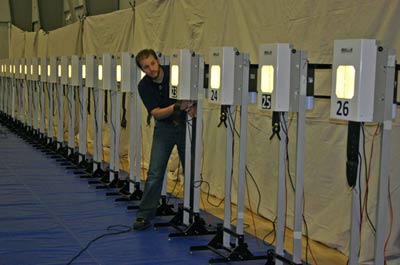
|
| CMP staff member James Hall sets up
the targets for the match. |
This year, for the first time, the Civilian Marksmanship Program (CMP) was asked to help run the shooting portion of the trials.
The shooting competition was held on Monday, March 4, which included a full day of matches for athletes and spectators. Of the 130 athletes participating in the shooting events, some were involved in multiple matches, accounting for the nearly 230 entries competing on the Camp Pendleton Hope and Care Center’s MEGAlink Targets. There were six relays in total, with eight finals. Athletes used regulation air rifles and pistols during the matches.
“It was very different for all of them because it was a different shooting style than they’re used to,” said Sarah Hall, CMP finance clerk who helped run the targets during the match. James Hall, CMP program outreach supervisor, also assisted at the trials.
“There were a lot of shooters participating, so it must be one of their favorite sports to compete in during the games,” Sarah added.
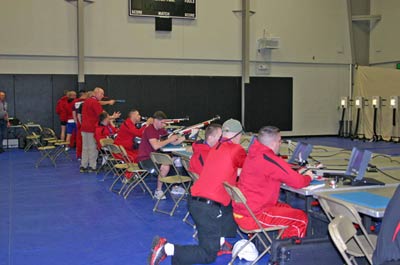
|
| Coaches work with athletes on the
line during practice time. |
After a week and a half of practice, three categories were sanctioned for the Warrior shooters, including rifle standing, rifle prone and pistol. To make the competition fair for all participants, each category was split into classes based on the athlete’s disabilities and injuries: SH1, SH2 and Open. Because each category was broken off into classes, except for pistol, which only incorporated SH1 and Open, eight total events were conducted during the trials.
Open athletes were considered as shooters that had no permanent physical disabilities, such as those with Post Traumatic Stress Disorder (PTSD) and Traumatic Brain Injury (TBI).
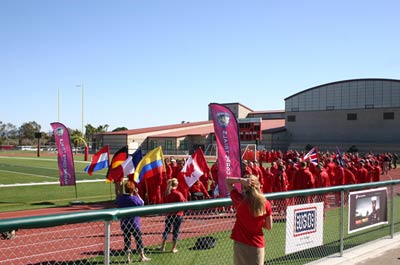
|
| The athletes carried their country’s
flags during the opening ceremonies. |
SH2 athletes were classified as those with disabilities that made them physically unable to hold up the rifles on their own, such as amputees or those with shrapnel in their shoulders. These athletes shot their matches off of a spring stand – a spring that sits on the table in front of the shooter, designed to hold the rifle up in the proper shooting position. SH2 athletes were also aided with a loader, who assisted in loading the shooter’s rifle or pistol every shot.
SH1 athletes were distinguished as those able to hold the rifle without any support, but still exhibited a disability that inhibited their ability to use the standard standing or prone positions. This included athletes in wheelchairs or those simply unable to stand for the duration of the match.
“I think a lot of them thought it was something they couldn’t do because of their injuries, but they realized they could. There was even a triple amputee – he only had one arm – and he could shoot,” Hall described. “It was pretty amazing to see them learn what they could do.”
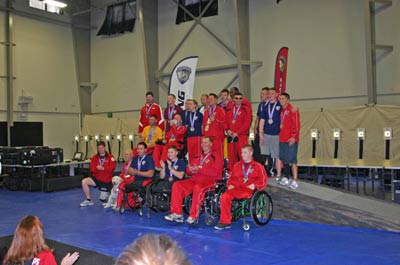
|
| Award winners stood proudly on the
podium after a hard-fought competition. |
The Marine Corps athletes participating in the trials were from different battalions around the world. There was a West, East and Vets battalion, which included shooters from the United States, as well as several Allie teams, traveling from countries such as Germany, France, Canada, New Zealand, Australia, Colombia, the Netherlands and the UK.
An Opening Ceremony was held on Feb. 23 on a windy and warm California day to welcome the athletes and their families from around the globe. The teams honored their countries by carrying their nation’s flags under the bright blue sky and listening to the playing of their national anthem. Athletes and their families opened the trials with pride, smiles and tears of joy.
“For a lot of them, it was their first time coming to the trials, so it was pretty emotional and powerful for them to be there,” Hall explained. “It was a really cool experience to see all of them there.”
The Closing Ceremony on March 6 displayed a new comradery amongst the athletes, as the Allie teams brought gifts for the U.S. Battalions, who also brought souvenirs for the Allies. Gifts included a kangaroo skin from the Australian team, a French jersey from the French team and other gifts native to the participating countries. In the end, the trials not only exposed the strength of Wounded Warriors around the world, but also gave CMP the opportunity to share its message of marksmanship to others.
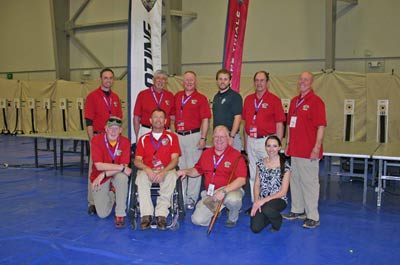
|
| CMP’s James Hall (standing) and Sarah
Hall (kneeling) posed with the USMC shooting coaches,
all in red. |
“It was a great way for us to expand what we do,” said Hall. “We like working with youth and in highpower events, and working with the Wounded Warriors gives us another venue to get shooting out there.”
The trials were a part of the Regiment’s Warrior Athlete Reconditioning program, which provides activities and opportunities for wounded, ill and injured Marines while also increasing their strength to allow them to continue with military service or develop healthy habits for life outside the service.
The Warrior Games is a Paralympic-style competition, set to take place May 11-17, 2013 at the Olympic Training Center and the Air Force Academy in Colorado Springs, CO. It will include events such as archery, shooting, wheelchair basketball, sitting volleyball, swimming, cycling and track and field. The Marine Corps athletes will compete head-to-head against other branches of the Armed Forces to defend their first place title.
For more information on the Warrior Games, visit the Military tab on the U.S. Paralympic website at
http://www.teamusa.org/US-Paralympics/Military/Warrior-Games-presented-by-Deloitte.aspx.
NEXT ARTICLE
|




